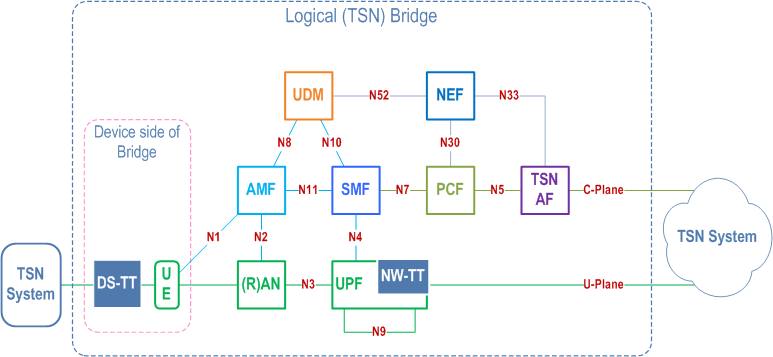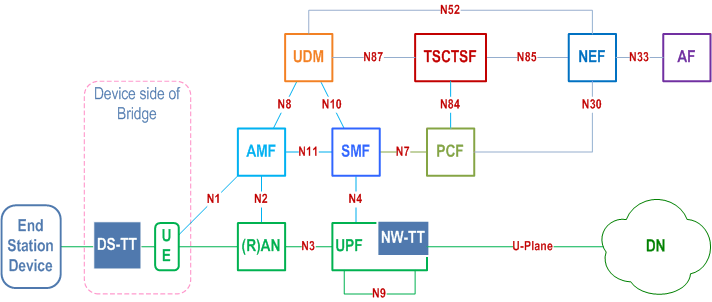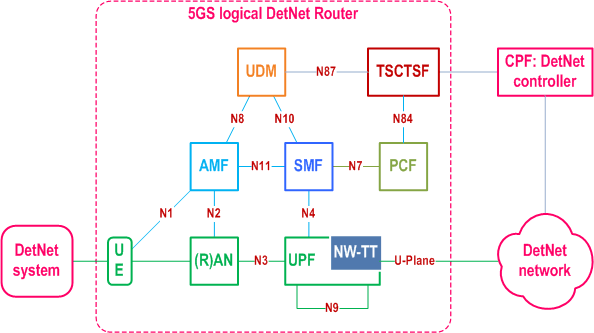Content for TS 23.501 Word version: 19.1.0
1…
3…
4.2.3
4.2.4
4.2.5…
4.2.8…
4.2.8.2.2
4.2.8.2.3…
4.2.8.4…
4.2.9…
4.2.15…
4.3…
4.3.3
4.3.4
4.3.5
4.4…
4.4.6…
4.4.8…
5…
5.3…
5.3.3…
5.4…
5.5…
5.6…
5.6.7…
5.7…
5.7.2…
5.7.3…
5.7.4
5.7.5…
5.8…
5.8.2.11…
5.9…
5.10…
5.11…
5.15…
5.15.11…
5.16…
5.17…
5.18…
5.19…
5.21…
5.22…
5.27…
5.28…
5.29…
5.30…
5.31…
5.32…
5.32.6…
5.33…
5.34…
5.35…
5.38…
5.43…
5.49…
6…
6.3…
6.3.8…
7…
7.2…
8…
8.2.4
8.2.5…
8.3…
A…
D…
E…
F
G…
G.3
G.4…
H…
J
K…
M…
N…
O…
P…
S…
4.4.8 Architecture to enable Time Sensitive Communication, Time Synchronization and Deterministic Networking
4.4.8.1 General
4.4.8.2 Architecture to support IEEE Time Sensitive Networking
4.4.8.3 Architecture for AF requested support of Time Sensitive Communication and Time Synchronization
4.4.8.4 Architecture to support IETF Deterministic Networking
...
...
4.4.8 Architecture to enable Time Sensitive Communication, Time Synchronization and Deterministic Networking |R16| p. 90
4.4.8.1 General p. 90
The 5G System can be extended to support the following:
- Integration of 5GS into a TSN data network (DN): Integration as a bridge in an IEEE 802.1 Time Sensitive Networking (TSN). The 5GS bridge supports the Time sensitive communication as defined in IEEE 802.1 Time Sensitive Networking (TSN) standards. The architecture is described in clause 4.4.8.2. This Release supports of the specification, integration of the 5G System with IEEE 802.1 TSN networks that apply the fully centralized configuration model as defined in IEEE Std 802.1Q [98]. IEEE TSN is a set of standards to define mechanisms for the time-sensitive (i.e. deterministic) transmission of data over Ethernet networks.
- Enablers for AF requested support of Time Synchronization and/or some aspects of Time Sensitive Communication. The architecture is described in clause 4.4.8.3.
- Support for TSN enabled transport network (TN): Enablers for interworking with TSN network deployed in the transport network. This option can be used simultaneously with either option a) or b). The architecture is described in clause 5.28a. The interworking is applicable when the transport network deploys the fully centralized configuration model as defined in IEEE Std 802.1Q [98]. In this scenario, a TSN TN is deployed to realize the N3 interface between (R)AN and UPF. From the perspective of the TSN TN, (R)AN and UPF act as End Stations of the TSN TN.
- Integration as a router in a Deterministic Network as defined in RFC 8655. The architecture is described in clause 4.4.8.4.
4.4.8.2 Architecture to support IEEE Time Sensitive Networking p. 91
The 5G System is integrated with the external network as a TSN bridge. This "logical" TSN bridge (see Figure 4.4.8.2-1) includes TSN Translator functionality for interoperation between TSN Systems and 5G System both for user plane and control plane. 5GS TSN translator functionality consists of Device-side TSN translator (DS-TT) and Network-side TSN translator (NW-TT). The TSN AF is part of 5GC and provides the control plane translator functionality for the integration of the 5GS with a TSN network, e.g. the interactions with the CNC. 5G System specific procedures in 5GC and RAN, wireless communication links, etc. remain hidden from the TSN network. To achieve such transparency to the TSN network and the 5GS to appear as any other TSN Bridge, the 5GS provides TSN ingress and egress ports via DS-TT and NW-TT. DS-TT and NW-TT optionally support:
- hold and forward functionality for the purpose of de-jittering;
- per-stream filtering and policing as defined in section 8.6.5.2.1 of IEEE Std 802.1Q [98].
There are three TSN configuration models defined in IEEE Std 802.1Q [98]. Amongst the three models:
- fully centralized model is supported in this Release of the specification;
- fully distributed model is not supported in this Release of the specification;
- centralized network/distributed user model is not supported in this Release of the specification.

4.4.8.3 Architecture for AF requested support of Time Sensitive Communication and Time Synchronization |R17| p. 92
This clause describes the architecture to enable Time Sensitive Communication AF requested time sensitive communication and time synchronization services. The Time Sensitive Communication and Time Synchronization related features that are supported based on AF request are described in clauses 5.27.1 and 5.27.2, respectively. Figure 4.4.8.3-1 shows the architecture to support Time Sensitive Communication and Time Synchronization services.
As shown in Figure 4.4.8.3-1, to support Time Synchronization service based on IEEE Std 802.1AS [104] or IEEE Std 1588 [126] for Ethernet or IP type PDU Sessions, the DS-TT, NW-TT and Time Sensitive Communication and Time Synchronization Function (TSCTSF) are required in order to support the features in IEEE Std 802.1AS [104] or IEEE Std 1588 [126] as described in clause 5.27. The NEF exposes 5GS capability to support Time Synchronization service as described in clause 5.27.1.8. TSCTSF controls the DS-TT(s) and NW-TT for the (g)PTP based time synchronization service. In addition, TSCTSF supports TSC assistance container related functionalities.

UPF/NW-TT distributes the (g)PTP messages as described in clause 5.27.1.
When the UPF supports one or more NW-TT(s), there is one-to-one association between an NW-TT and the network instance or between an NW-TT and network instance together with DNN/S-NSSAI in the UPF. When there are multiple network instances within a UPF, each network instance is considered logically separate. The network instance for the N6 interface (clause 5.6.12) may be indicated by the SMF to the UPF for a given PDU Session during PDU Session establishment procedure. UPF allocates resources based on the Network Instance and S-NSSAI and it is supported according to TS 29.244. DNN/S-NSSAI may be indicated by the SMF together with the network instance to the UPF for a given PDU Session during PDU Session establishment procedure.
4.4.8.4 Architecture to support IETF Deterministic Networking |R18| p. 92
The 5G System is integrated with the Deterministic Network as defined in RFC 8655 as a logical DetNet transit router, see Figure 4.4.8.4-1. The TSCTSF performs mapping in the control plane between the 5GS internal functions and the DetNet controller. 5G System specific procedures in 5GC and RAN remain hidden from the DetNet controller.

On the device side, the UE is connected with a DetNet system, which may be a DetNet End System or a DetNet Node.
The architecture does not require the DS-TT functionality to be supported in the device nor require the user plane NW-TT functionality to be supported in the UPF, however, it can co-exist with such functions. For the reporting of information of the network side ports, NW-TT control plane function is used. The architecture can be combined with architecture in clause 4.4.8.3 to support time synchronization and TSC.
DetNet may be used in combination with time synchronization mechanisms as defined in clause 5.27, but it does not require usage of these mechanisms.
5GS acts as a DetNet router in the DetNet domain. Use cases where the 5GS acts as a sub-network (see Section 4.1.2 of RFC 8655) are also possible but do not require any additional 3GPP standardization. A special case where the 5GS can act as a sub-network is when the 5GS acts as a TSN network, which is supported by the 3GPP specifications based on the architecture in clause 4.4.8.2.
The routing of the downlink packets is achieved using the existing 3GPP functions.